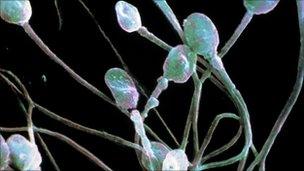French sperm count 'falls by a third'
- Published

The sperm count of French men fell by a third between 1989 and 2005, a study suggests.
The semen of more than 26,600 French men was tested in the study, reported in the journal Human Reproduction.
The number of millions of spermatozoa per millilitre fell by 32.3%, a rate of about 1.9% a year. And the percentage of normally shaped sperm fell by 33.4%.
The average sperm count remained within the fertile range, but experts want to see more research into possible causes.
One of the paper's authors, Dr Joelle Le Moal, an environmental health epidemiologist, said: "To our knowledge, this is the first study concluding a severe and general decrease in sperm concentration and morphology at the scale of a whole country over a substantial period.
"This constitutes a serious public health warning."
But Dr Allan Pacey, senior lecturer in andrology at the University of Sheffield, said: "The change in sperm concentration described, 73.6 to 49.9 million per millilitre [on average for a 35-year-old], is still well within the normal range and above the lower threshold of concern used by doctors which is suggestive of male infertility, 15 million per millilitre."
There has much been debate in the past 20 years over whether sperm quality has decreased, with research supporting both sides of the controversy. This latest research adds weight to the numerous European studies that suggest one in five young men has a sperm count low enough to impair fertility.
Prof Richard Sharpe, from the University of Edinburgh, said: "Something in our modern lifestyle, diet or environment like chemical exposure, is causing this.
"We still do not know which are the most important factors, but perhaps the most likely is a combination, a double whammy of changes, such as a high-fat diet combined with increased environmental chemical exposures."
The study analysed data from the French database Fivnat, which logs information from 126 assisted reproduction centres. Researchers examined semen samples provided by men aged between 18-70 whose partners were undergoing fertility treatment because of blocked or missing fallopian tubes.
'Jury out'
As the study took place over a period of years, it is important that methods remained the same for comparison- but critics have questioned this.
Dr Pacey said: "In the paper, the authors claim that the methods for measurement of sperm concentration and motility 'have not changed noticeably during the study period', yet to me this is an odd thing to say as in my experience they have changed remarkably everywhere else in the world.
"I would argue that the 'jury is still out' on this issue."
While the study took into account factors that can affect sperm quality, such as age, researchers were unable to control for socio-economic factors, smoking or weight, which have been shown to have a major impact.
- Published14 March 2012
- Published13 June 2012
- Published17 August 2012
- Published4 March 2011